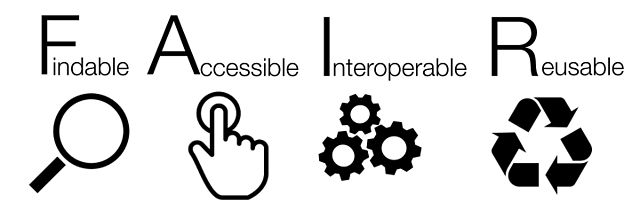Fair Principles
Vast amounts of data are available online and are being generated daily by an increasingly technological science. To assure that data is always easily discoverable and accessible, some practices can be put in place to guide this process. The FAIR principles aim to make data Findable, Accessible, Interoperable and Reusable. These guidelines were first introduced in a workshop held in Leiden in 2014, where a group of like-minded academic and private stakeholders met to discuss ways to overcome obstacles in data discovery and reuse.
Findable
Findable data can be assured by defining a unique persistent identifier (e.g. DOI or URI), by incorporating the data with rich metadata following recognized norms that itself includes the identifier, and finally, ensuring (meta)data are registered or indexed in both regional and international open data discovery portals or search engines.
Accessible
Being accessible means that data can be easily accessed by humans as well as by machines, through well-defined and standardized protocols. Access conditions must be clearly established (license, re-use rights, etc.). Even when the data itself is not accessible or no longer available, the metadata remains so in a way that the dataset remains discoverable. The author of the dataset can then be reached for a data access request or more information (for example, under specific conditions).
Interoperable
Interoperability makes it possible for the data to be integrated with other data into an interface, for example within the same web application. This can be achieved in many of ways: the use of a formal, accessible, shared, and broadly applicable programming language, the use of controlled vocabulary, as well as non-proprietary formats. The same efforts can be applied to metadata as well as qualified references to other (meta)data.
Re-Usable
By having data and metadata following best practices, it is possible to optimize them for re-use, the ultimate goal of FAIR. Data and metadata must be well-described so that they can be replicated and/or combined in different settings. There should be a clear and accessible data usage license, as well as a detailed provenance.
Sources:
https://www.nature.com/articles/sdata201618
https://www.go-fair.org/fair-principles/

